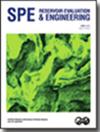Broad Ion Beam–Scanning Electron Microscopy Characterization of Organic Porosity Evolution During Thermal Treatment of Bazhenov Shale Sample
IF 1.5
4区 工程技术
Q3 ENERGY & FUELS
引用次数: 2
Abstract
Organic matter-hosted pores are considered as the main type of porosity in organic-rich shales. At the same time, literature indicates the formation of pore space during pyrolysis of oil shales. However, controls, evolution, and types of organic porosity remain controversial. This study aims to experimentally investigate the evolution of organic pores in an organic-rich shale sample during thermal treatment. This paper reports the organic porosity evolution during an artificial maturation experiment of the Bazhenov Formation (BF) shale sample (West Siberian Petroleum Basin). The siliceous-argillaceous organic-rich shale immature nonporous rock sample was treated in an open system in the temperature range of 350–450°C with the step of 10°C. Organic porosity was characterized by the combination of broad ion beam (BIB) polishing and scanning electron microscopy (SEM). After each episode of treatment, the area of 1000×1000 μm was scanned with a resolution of 25 nm. The acquired mosaic SEM images were segmented by the neural network algorithm and quantitatively analyzed. We demonstrate direct experimental evidence that thermal maturation/thermal treatment influence on organic porosity development. Organic porosity evolution is shown within the individual organic matter (OM) particles throughout the experiment. Thermal treatment leads to the formation of two types of organic pores, which are shrinkage and spongy pores. The first shrinkage pores start to form after the evacuation of existing hydrocarbons; they are relatively large and might reach 7 µm. This type of pore dominates at the initial stages of treatment (350–390°C). Porosity at this stage does not exceed 1.4%. The second type is spongy pores, which are up to 3–5 μm in size and are potentially formed due to hydrocarbon generation from the kerogen. This type of porosity becomes major after 400°C. This is confirmed by the pore size distribution analysis. The porosity spikes up to 2.3% after 400°C and rises up to 2.9% after 450°C. Revealing of artificial organic porosity development during thermal treatment experiment shows the crucial importance of the thermal maturity level. The formation of pore space during the treatment is critical during the implementation of thermal enhanced oil recovery (EOR) technologies in shales for fluid flow, and a mandatory aspect that should be accounted during thermal EOR simulations.巴治诺夫页岩热处理过程中有机孔隙演化的宽离子束扫描电镜表征
有机质孔隙被认为是富有机质页岩孔隙的主要类型。同时,文献表明油页岩在热解过程中形成孔隙空间。然而,控制、演化和有机孔隙的类型仍然存在争议。本研究旨在通过实验研究富有机质页岩样品在热处理过程中有机孔隙的演化。本文报道了西西伯利亚盆地巴济诺夫组(BF)页岩样品在人工成熟实验过程中的有机孔隙度演化。将硅泥质富有机质页岩未成熟无孔岩石样品在350 ~ 450℃的开放体系中处理,步长为10℃。采用宽离子束(BIB)抛光和扫描电镜(SEM)相结合的方法对有机孔隙度进行了表征。每次治疗后,以25 nm的分辨率扫描1000×1000 μm区域。利用神经网络算法对采集到的拼接SEM图像进行分割并定量分析。我们证明了热成熟/热处理对有机孔隙发育的直接实验证据。在整个实验过程中,有机孔隙度在单个有机质(OM)颗粒内演化。热处理导致两种类型的有机孔的形成,即收缩孔和海绵状孔。第一个收缩孔在现有烃类被抽离后开始形成;它们相对较大,可能达到7µm。这种类型的孔隙在处理的初始阶段(350-390°C)占主导地位。该阶段孔隙度不超过1.4%。第二类为海绵状孔隙,孔径可达3 ~ 5 μm,可能是由干酪根生烃形成的。这种孔隙率在400℃后变得主要。孔径分布分析证实了这一点。孔隙率在400℃后达到2.3%,450℃后达到2.9%。热处理实验中人工有机孔隙发育的揭示表明了热成熟度水平的重要性。处理过程中孔隙空间的形成对于页岩热提高采收率(EOR)技术的流体流动至关重要,也是热提高采收率模拟过程中必须考虑的一个方面。
本文章由计算机程序翻译,如有差异,请以英文原文为准。
求助全文
约1分钟内获得全文
求助全文
来源期刊
CiteScore
5.30
自引率
0.00%
发文量
68
审稿时长
12 months
期刊介绍:
Covers the application of a wide range of topics, including reservoir characterization, geology and geophysics, core analysis, well logging, well testing, reservoir management, enhanced oil recovery, fluid mechanics, performance prediction, reservoir simulation, digital energy, uncertainty/risk assessment, information management, resource and reserve evaluation, portfolio/asset management, project valuation, and petroleum economics.

 求助内容:
求助内容: 应助结果提醒方式:
应助结果提醒方式:


